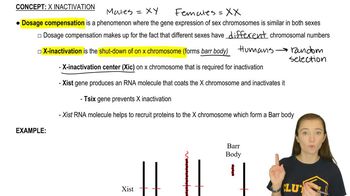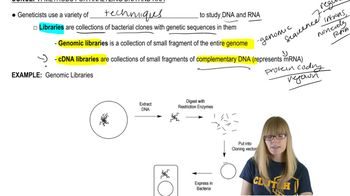Table of contents
- 1. Introduction to Genetics51m
- 2. Mendel's Laws of Inheritance3h 37m
- 3. Extensions to Mendelian Inheritance2h 41m
- 4. Genetic Mapping and Linkage2h 28m
- 5. Genetics of Bacteria and Viruses1h 21m
- 6. Chromosomal Variation1h 48m
- 7. DNA and Chromosome Structure56m
- 8. DNA Replication1h 10m
- 9. Mitosis and Meiosis1h 34m
- 10. Transcription1h 0m
- 11. Translation58m
- 12. Gene Regulation in Prokaryotes1h 19m
- 13. Gene Regulation in Eukaryotes44m
- 14. Genetic Control of Development44m
- 15. Genomes and Genomics1h 50m
- 16. Transposable Elements47m
- 17. Mutation, Repair, and Recombination1h 6m
- 18. Molecular Genetic Tools19m
- 19. Cancer Genetics29m
- 20. Quantitative Genetics1h 26m
- 21. Population Genetics50m
- 22. Evolutionary Genetics29m
18. Molecular Genetic Tools
Methods for Analyzing DNA
Problem 2
Textbook Question
Compare and contrast the terms Paternity Index (PI) and Combined Paternity Index (CPI). How does each contribute to paternity determination?
 Verified step by step guidance
Verified step by step guidance1
Step 1: Define the Paternity Index (PI). The Paternity Index is a genetic calculation used to evaluate the likelihood that a man is the biological father of a child. It compares the probability of the child's genetic markers being inherited from the alleged father versus a random man from the population.
Step 2: Explain how PI is calculated. The PI is calculated for each genetic marker (locus) by dividing the probability that the alleged father transmitted the observed allele to the child by the probability that a random man from the population transmitted the same allele.
Step 3: Define the Combined Paternity Index (CPI). The Combined Paternity Index is the product of the Paternity Indices for all tested genetic markers. It provides a cumulative measure of the likelihood of paternity across multiple loci.
Step 4: Discuss the role of PI in paternity determination. The PI for each locus provides evidence for or against paternity. A PI greater than 1 suggests that the alleged father is more likely to be the biological father than a random man, while a PI less than 1 suggests the opposite.
Step 5: Discuss the role of CPI in paternity determination. The CPI aggregates the evidence from all loci, providing a comprehensive measure of paternity likelihood. A higher CPI indicates stronger evidence supporting paternity, and it is often used to calculate the probability of paternity, which is expressed as a percentage.
Recommended similar problem, with video answer:
 Verified Solution
Verified SolutionThis video solution was recommended by our tutors as helpful for the problem above
Video duration:
1mPlay a video:
Was this helpful?
Key Concepts
Here are the essential concepts you must grasp in order to answer the question correctly.
Paternity Index (PI)
The Paternity Index (PI) is a statistical measure used in paternity testing that compares the likelihood of a genetic profile being present in a child if the alleged father is the biological parent versus if he is not. A PI greater than 1 indicates that the evidence supports the alleged father being the biological parent, while a PI less than 1 suggests the opposite. It is calculated for each genetic marker tested.
Recommended video:
Guided course

Regulation
Combined Paternity Index (CPI)
The Combined Paternity Index (CPI) is an extension of the Paternity Index that integrates the PIs from multiple genetic markers to provide a more comprehensive assessment of paternity. The CPI is calculated by multiplying the PIs of all the markers tested, resulting in a single value that reflects the overall strength of the evidence. A higher CPI indicates a stronger likelihood of paternity.
Recommended video:
Guided course

X-Inactivation
Paternity Determination
Paternity determination involves using genetic testing to establish whether a man is the biological father of a child. This process typically relies on analyzing specific genetic markers, such as short tandem repeats (STRs), to compare the DNA of the child, the alleged father, and sometimes the mother. The results, expressed through PI and CPI, help quantify the probability of paternity, aiding legal and personal decisions.
Recommended video:
Guided course

Sex Determination

 7:40m
7:40mWatch next
Master Methods for Analyzing DNA and RNA with a bite sized video explanation from Kylia Goodner
Start learningRelated Videos
Related Practice


